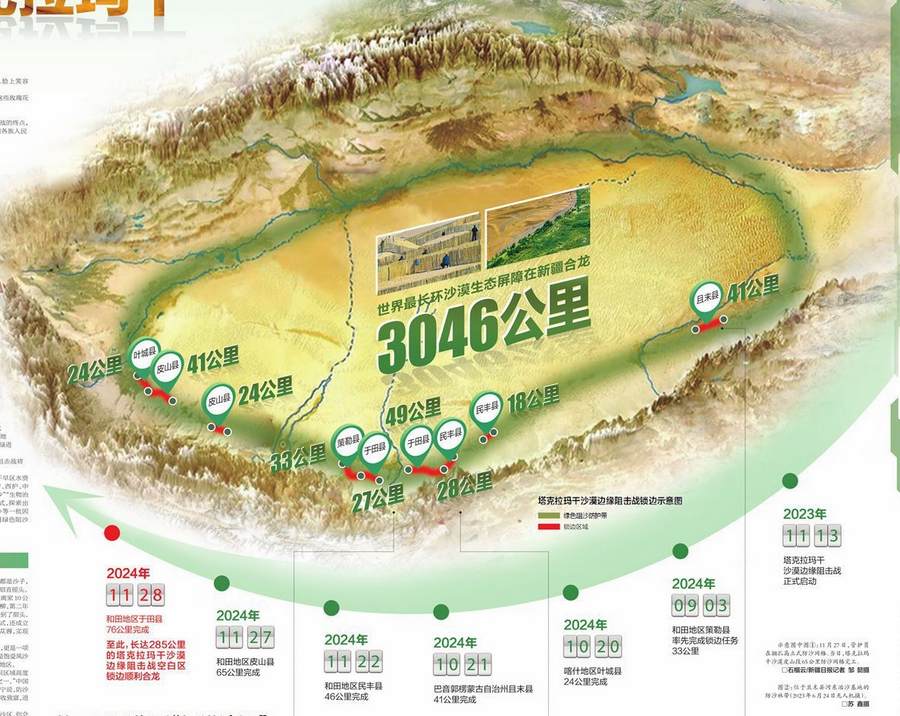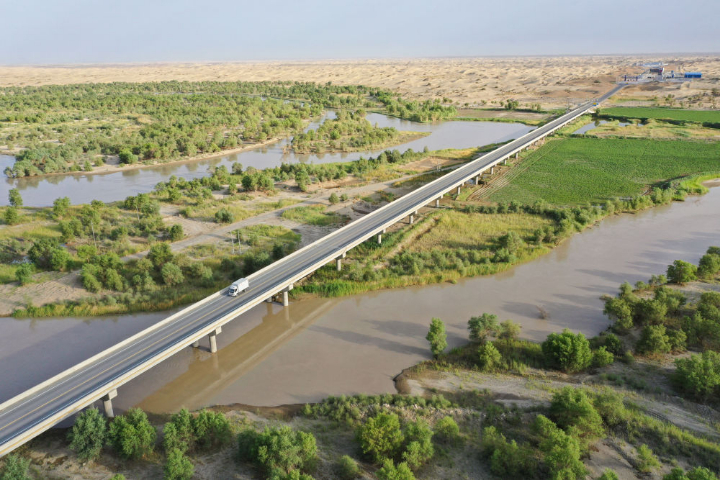
On November 28, 2024, a significant milestone was achieved in China's desertification control efforts: a 3,046-kilometer-long green sand-blocking barrier around the edge of the Taklamakan Desert in Xinjiang was fully completed. This remarkable achievement marks the culmination of a 40-year-long battle against the shifting sands by hundreds of thousands of people.

The Taklamakan Desert, known as the "Sea of Death," is the second-largest mobile desert in the world. Its southern region, with intense wind and sand activities, has been eroding oasis areas at a rate of 2 to 5 meters per year. In Yutian County, part of the Hotan Prefecture, the oasis covers less than 6% of the county's total area due to such erosion. To combat this, the Chinese government initiated the "Three-North" Shelterbelt Forest Program in 1978, aimed at constructing large-scale shelter forests in key areas suffering from wind and sand hazards and water and soil loss.
Over the past 40 years, relentless efforts have led to the establishment of 70 million mu (about 4.67 million hectares) of trees in wind and sand hazard areas in Xinjiang. The forest coverage rate has increased from 1.03% in 1978 to 5.06% currently. During the past 30 years, the artificial oasis area in Xinjiang has expanded from 65,000 square kilometers to 100,000 square kilometers, marking a 54% increase.
This is a protective forest belt photographed in Hetian County, Hotan Prefecture, Xinjiang. On both sides of the road are desert forage bases and facilities for agricultural production (photographed by a drone on June 20, 2024). Xinhua News Agency reporter Ding Lei took the photo.

The completion of the green barrier is a monumental achievement for China, effectively halting the desert's expansion. Yutian County, for instance, has witnessed a reduction in sandstorm days from 179 to around 120 annually compared to a decade ago. Vegetation is thriving along the sand-blocking barrier, continuously expanding the green frontier.
The Yutian-Qiemo desert highway, which traverses the Tarim River and Populus euphratica forests, photographed on June 22, 2022 (drones captured the image). Xinhua News Agency reporter Li Xiang took the photo.

Scientific sand control methods have been explored and implemented. In Minfeng County, grass squares have been laid to stabilize shifting dunes, while high-standing sand barriers have been constructed in regions with wide sand edges and strong winds in Pishan and Yecheng counties. Mechanical and intelligent sand control tools are also being widely used, optimizing sand control efficiency.
This is a photo taken in Minfeng County, Hotan Prefecture, Xinjiang, of the Houheba Desert Intercept Zone (photographed by a drone on December 2, 2024). Xinhua News Agency reporter Wang Fei took the photo.

Moreover, green development has gained momentum. With the support of policies and incentives, locals have been encouraged to invest in sand control and develop sand industries. For example, Mamuti Maitisaidi plans to cultivate tamarisk and Cistanche deserticola on his 700-mu (about 46.67 hectares) contracted sandy land. The development of sand industries has not only brought economic benefits but also promoted related industries such as processing, storage, and transportation.
Maimaiti Maimiseidi (left) and his wife inspect the leveling of their newly contracted 700 mu of sandy land (photographed on December 4, 2024). Xinhua News Agency reporter Wang Fei took the photo.

The transformation of the "Sea of Death" into a vibrant land demonstrates China's commitment to harmonious coexistence with nature. The ecological barrier around the Taklamakan Desert is not the end but the beginning of sand control efforts. Continuous efforts will be made to consolidate and expand the green barrier, laying a solid foundation for the high-quality development of sand industries.
This is a photo taken at the construction site of the desert highway from Yutian County to Qiemo County in Xinjiang, showing "reed sand barriers" used for wind protection and sand fixation (photographed on July 10, 2018). Xinhua News Agency reporter Hu Hohhot took the photo.

Source:Xinhua News Agency
http://www.news.cn/20241215/cd30d702b5684ee89aee7a0fabc58f81/c.html
